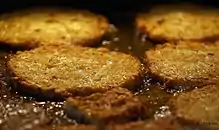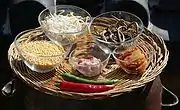Bindae-tteok
Bindae-tteok (빈대떡), or mung bean pancake, is a type of buchimgae (Korean pancake) that originated in the Pyongan Province.[2][3] It is made by grinding soaked mung beans, adding vegetables and meat and pan-frying it into a round, flat shape.[4]
 Bindae-tteok being fried in Gwangjang Market | |
| Alternative names | Mung bean pancake, nokdu-buchimgae, nokdu-jeon, nokdu-jeonbyeong, nokdu-jijim |
|---|---|
| Type | Buchimgae |
| Place of origin | Korea |
| Associated national cuisine | Korean cuisine |
| Main ingredients | Mung beans |
| 35 kcal (147 kJ)[1] | |
| Other information | |
| Korean name | |
| Hangul | 빈대떡 |
| Revised Romanization | bindae-tteok |
| McCune–Reischauer | pindae-ttŏk |
| IPA | [pin.dɛ̝.t͈ʌk̚] |
Etymology and history
Bindae-tteok first appears under the name binja (빈쟈) in the Guidebook of Homemade Food and Drinks, a 1670 cookbook written by Jang Gye-hyang.[5] The word appears to be derived from bingjya (빙쟈), the Middle Korean transcription of the Chinese word 餠𩜼, whose first character is pronounced bǐng in Chinese and means "round and flat pancake-like food".[6][7] The pronunciation and the meaning of the second letter are unknown.[8] Tteok (떡) means a steamed, boiled, or pan-fried cake; usually a rice cake but in this case a pancake.
During the Joseon era (1392–1897), richer households would dispense bindae-tteok to poorer people gathered outside the South Great Gate of Seoul during times of hardship.[9]
Preparation
Bindae-tteok is made with the mung bean batter with a filling made of bracken, pork, mung bean sprouts, and baechu-kimchi (napa cabbage kimchi).[1]
To make the filling for bindae-tteok, soaked bracken is cut into short pieces, mixed with ground pork, and seasoned with soy sauce, chopped scallions, minced garlic, ground black pepper, and sesame oil.[1] Mung bean sprouts are washed, blanched, cut into short pieces and seasoned with salt and sesame oil.[1] Kimchi is unstuffed and squeezed to remove its fillings and excess juice, then cut into small pieces.[1] The ingredients are then mixed.[1]
Washed, soaked, and husked mung beans are ground with water and seasoned with salt to make the batter.[1]
The mung bean batter is ladled on a hot frying pan greased with a considerable amount of cooking oil, topped with the filling, and followed by another layer of the batter poured over the top of the filling. Finally, the bindae-tteok is topped with pieces of diagonally sliced green and red chili pepper.[1] The pancakes are pan-fried on both sides, and served with a dipping sauce consisting of soy sauce, vinegar, water, and ground pine nuts.[1]
Gallery
 Ingredients for bindae-tteok
Ingredients for bindae-tteok Pan-frying bindae-tteok
Pan-frying bindae-tteok Bindae-tteok
Bindae-tteok Street food bindae-tteok
Street food bindae-tteok
References
- "bindae-tteok" 빈대떡. Korean Food Foundation (in Korean). Retrieved 25 May 2017.
- National Institute of Korean Language (30 July 2014). "주요 한식명(200개) 로마자 표기 및 번역(영, 중, 일) 표준안" (PDF) (in Korean). Retrieved 19 February 2017. Lay summary – National Institute of Korean Language.
- Gentile, Dan (28 February 2014). "Korean food: The 12 essential dishes you need to know from the North and the South". Thrillist. Retrieved 19 May 2017.
- "bindaetteok" 빈대떡. Korean–English Learners' Dictionary. National Institute of Korean Language. Retrieved 8 December 2016.
- Jang, Gyehyang (1670). Eumsik dimibang 음식디미방 [Guidebook of Homemade Food and Drinks] (in Korean). Joseon Korea. Archived from the original on 2019-01-12. Retrieved 2017-05-25.
빈쟈법
녹두 뉘 업시 거피여 되게 라 기 므디 아니케 부어 히고 젹게 노코 거피 에 라 소 녀코 그 우희 녹도 니로 더퍼 빗치 유지빗 치 지져사 죠니라 - "bindae-tteok" 빈대떡. Standard Korean Language Dictionary (in Korean). National Institute of Korean Language. Retrieved 25 May 2017.
- Unknown (1682). Yeogeo yuhae 역어유해(譯語類解) [Categorical Analysis of the Chinese Language Translation] (in Korean). Joseon Korea: Sayeogwon. Lay summary – Korean Food Foundation.
- Sturgeon, Donald. "𩜼 U+2973C". Chinese Text Project. Retrieved 25 May 2017.
- 정, 순자. "bindae-tteok" 빈대떡. Encyclopedia of Korean Culture (in Korean). Academy of Korean Studies. Retrieved 25 May 2017.
